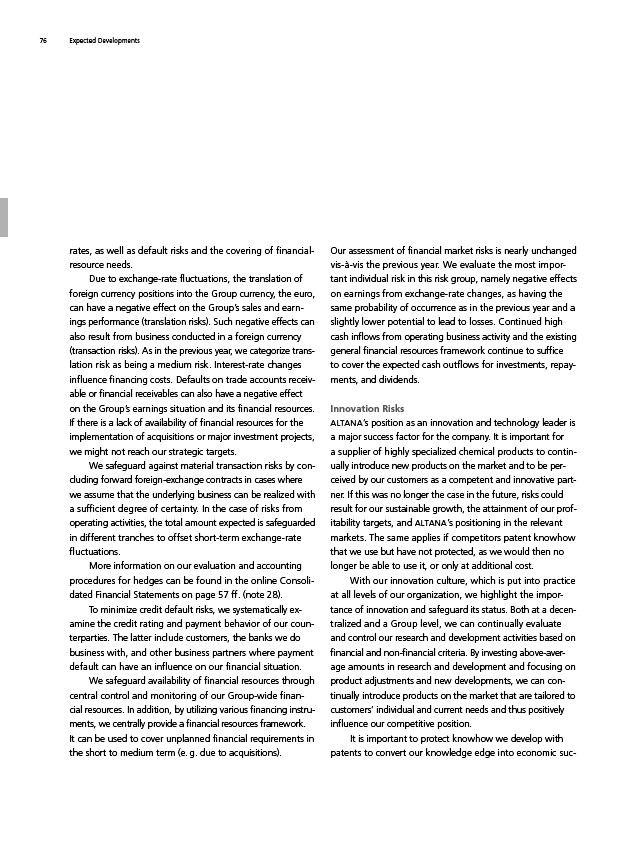
rates, as well as default risks and the covering of financial-
resource needs.
Due to exchange-rate fluctuations, the translation of
foreign currency positions into the Group currency, the euro,
can have a negative effect on the Group’s sales and earnings
performance (translation risks). Such negative effects can
also result from business conducted in a foreign currency
(transaction risks). As in the previous year, we categorize translation
risk as being a medium risk. Interest-rate changes
influence financing costs. Defaults on trade accounts receivable
or financial receivables can also have a negative effect
on the Group’s earnings situation and its financial resources.
If there is a lack of availability of financial resources for the
implementation of acquisitions or major investment projects,
we might not reach our strategic targets.
We safeguard against material transaction risks by concluding
forward foreign-exchange contracts in cases where
we assume that the underlying business can be realized with
a sufficient degree of certainty. In the case of risks from
operating activities, the total amount expected is safeguarded
in different tranches to offset short-term exchange-rate
fluctuations.
More information on our evaluation and accounting
procedures for hedges can be found in the online Consolidated
Financial Statements on page 57 ff. (note 28).
To minimize credit default risks, we systematically ex-
amine the credit rating and payment behavior of our counterparties.
The latter include customers, the banks we do
business with, and other business partners where payment
default can have an influence on our financial situation.
We safeguard availability of financial resources through
central control and monitoring of our Group-wide finan-
cial resources. In addition, by utilizing various financing instruments,
we centrally provide a financial resources framework.
It can be used to cover unplanned financial requirements in
the short to medium term (e. g. due to acquisitions).
Our assessment of financial market risks is nearly unchanged
vis-à-vis the previous year. We evaluate the most impor-
tant individual risk in this risk group, namely negative effects
on earnings from exchange-rate changes, as having the
same probability of occurrence as in the previous year and a
slightly lower potential to lead to losses. Continued high
cash inflows from operating business activity and the existing
general financial resources framework continue to suffice
to cover the expected cash outflows for investments, repayments,
and dividends.
Innovation Risks
ALTANA’s position as an innovation and technology leader is
a major success factor for the company. It is important for
a supplier of highly specialized chemical products to continually
introduce new products on the market and to be perceived
by our customers as a competent and innovative partner.
If this was no longer the case in the future, risks could
result for our sustainable growth, the attainment of our profitability
targets, and ALTANA’s positioning in the relevant
markets. The same applies if competitors patent knowhow
that we use but have not protected, as we would then no
longer be able to use it, or only at additional cost.
With our innovation culture, which is put into practice
at all levels of our organization, we highlight the importance
of innovation and safeguard its status. Both at a decentralized
and a Group level, we can continually evaluate
and control our research and development activities based on
financial and non-financial criteria. By investing above-average
amounts in research and development and focusing on
product adjustments and new developments, we can con-
tinually introduce products on the market that are tailored to
customers’ individual and current needs and thus positively
influence our competitive position.
It is important to protect knowhow we develop with
patents to convert our knowledge edge into economic suc-
76 Expected Developments